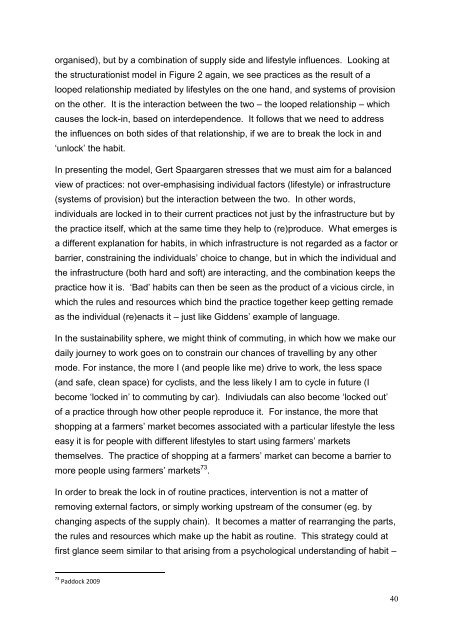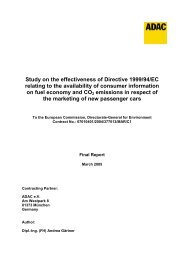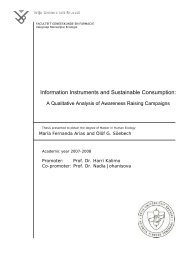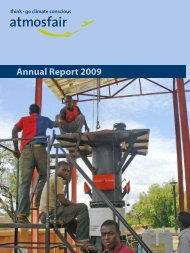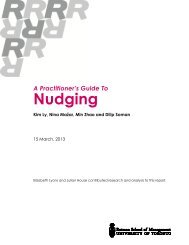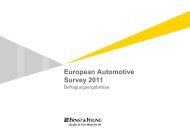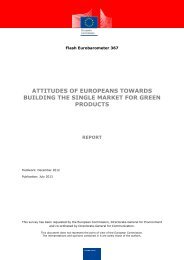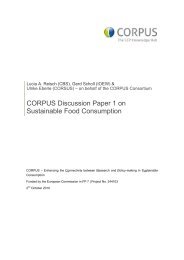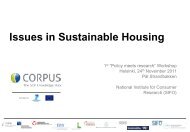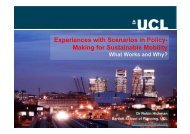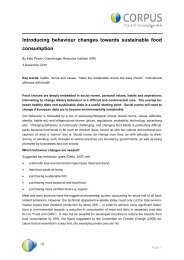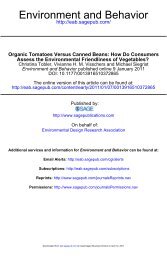Habits, Routines and Sustainable Lifestyles Summary Report
Habits, Routines and Sustainable Lifestyles Summary Report
Habits, Routines and Sustainable Lifestyles Summary Report
Create successful ePaper yourself
Turn your PDF publications into a flip-book with our unique Google optimized e-Paper software.
organised), but by a combination of supply side <strong>and</strong> lifestyle influences. Looking at<br />
the structurationist model in Figure 2 again, we see practices as the result of a<br />
looped relationship mediated by lifestyles on the one h<strong>and</strong>, <strong>and</strong> systems of provision<br />
on the other. It is the interaction between the two – the looped relationship – which<br />
causes the lock-in, based on interdependence. It follows that we need to address<br />
the influences on both sides of that relationship, if we are to break the lock in <strong>and</strong><br />
„unlock‟ the habit.<br />
In presenting the model, Gert Spaargaren stresses that we must aim for a balanced<br />
view of practices: not over-emphasising individual factors (lifestyle) or infrastructure<br />
(systems of provision) but the interaction between the two. In other words,<br />
individuals are locked in to their current practices not just by the infrastructure but by<br />
the practice itself, which at the same time they help to (re)produce. What emerges is<br />
a different explanation for habits, in which infrastructure is not regarded as a factor or<br />
barrier, constraining the individuals‟ choice to change, but in which the individual <strong>and</strong><br />
the infrastructure (both hard <strong>and</strong> soft) are interacting, <strong>and</strong> the combination keeps the<br />
practice how it is. „Bad‟ habits can then be seen as the product of a vicious circle, in<br />
which the rules <strong>and</strong> resources which bind the practice together keep getting remade<br />
as the individual (re)enacts it – just like Giddens‟ example of language.<br />
In the sustainability sphere, we might think of commuting, in which how we make our<br />
daily journey to work goes on to constrain our chances of travelling by any other<br />
mode. For instance, the more I (<strong>and</strong> people like me) drive to work, the less space<br />
(<strong>and</strong> safe, clean space) for cyclists, <strong>and</strong> the less likely I am to cycle in future (I<br />
become „locked in‟ to commuting by car). Indiviudals can also become „locked out‟<br />
of a practice through how other people reproduce it. For instance, the more that<br />
shopping at a farmers‟ market becomes associated with a particular lifestyle the less<br />
easy it is for people with different lifestyles to start using farmers‟ markets<br />
themselves. The practice of shopping at a farmers‟ market can become a barrier to<br />
more people using farmers‟ markets 73 .<br />
In order to break the lock in of routine practices, intervention is not a matter of<br />
removing external factors, or simply working upstream of the consumer (eg. by<br />
changing aspects of the supply chain). It becomes a matter of rearranging the parts,<br />
the rules <strong>and</strong> resources which make up the habit as routine. This strategy could at<br />
first glance seem similar to that arising from a psychological underst<strong>and</strong>ing of habit –<br />
73 Paddock 2009<br />
40


